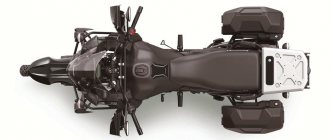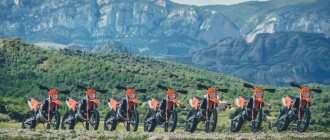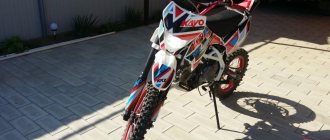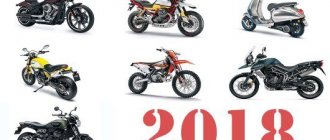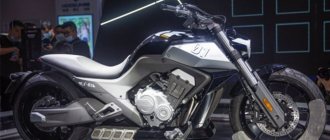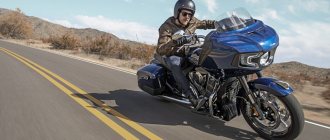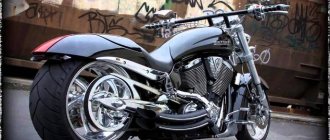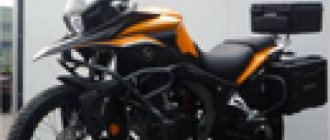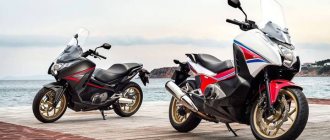The Austrian company KTM is one of the largest and most famous manufacturers of sports motorcycles in Europe. The official founding date of the company is 1934. It was then that a young but very ambitious engineer named Hans Trunkenpolz, who lived in the city of Mattinghofen, opened a metal processing workshop, which received the difficult name for a Russian person Kraftfahrzeuge Trunkenpolz Mattighofen (KTM).
At first, the young entrepreneur did not succeed in everything, but literally a few years after the start of commercial activity, he began to earn a stable income. And almost 20 years later, already in 1953, Trunkenpolz managed to begin the serial assembly of small motorcycles and mopeds, which were equipped with 2-stroke engines purchased from other developers.
Paying attention to the local success of a small company, which consisted of only a few dozen employees who jointly assembled three motorcycles a day, successful businessman Ernst Kronreif acquired a controlling stake in the company and became its main shareholder. Of course, after this the company received an updated name, which included the name of the new co-owner. However, this did not affect the abbreviation. It remains the same – KTM (Kronreif & Trunkenpolz Mattighofen).
The reorganized enterprise continued to assemble light motorcycles, and therefore was able to gain a decent share of the Austrian market. The cost of KTM products was more than acceptable, because the motorcycles of this company were excellently bought up by representatives of the middle class, among whom there were always a lot of people interested.
The systematic development of the enterprise continued until the end of the 60s. But the course of history was changed by the company’s specialists developing their own engine. It was then that the essence of Kronreif & Trunkenpolz Mattighofen's existence ceased to be reduced to assembling motorcycles from parts produced by other developers. Moreover, almost immediately, several debut models of the company were presented simultaneously, among which the off-road version, as well as a powerful sports bike, especially stood out.
In the early 70s, the KTM sports model turned out to be so successful that the company had to seriously engage in the sports component of motorcycle production. And it immediately bore fruit. In 1974, Soviet rider Gennady Moiseev, representing the KTM team, became the world motocross champion in the 250 cubic centimeter class. This was only the first success of the company, which was subsequently repeated many times. Moiseev alone won the championship twice more - in 1977 and 1978.
In the 80s of the last century, work on the layout of motorcycles continued actively. In the second half of the decade, KTM representatives managed to introduce several completely new principles of motorcycle operation, thanks to which the popularity of Austrian developments continued to grow.
However, 1989 put an end to the rapid development of the enterprise. The end of the “golden era” is usually associated with the death of the founder and main ideologist of the company, Hans Trunkenpolz. Almost immediately, KTM began to have serious problems, resulting in the company going bankrupt in 1991. However, the competence of the company's new management helped the Austrian motorcycle manufacturer get out of the hole.
In 1992, the company was divided into three companies: KTM Sportmotorcycles GmbH (production of sports motorcycles), KTM Fahrrad GmbH (production of bicycles) and KTM Kuhler GmbH (production of radiators). Almost immediately the company began its revival. And the marketing department of the sports department has completely developed a new operating philosophy (“Ready for the Race”). According to this principle, each of the KTM models had to undergo a full test of readiness for sports competitions before leaving the factory. Thus, each motorcycle produced by KTM can be called a full-fledged sports bike, tested by a professional racer.
The beginning of the new century turned out to be no less successful for the company than the end of the old: already in 2000, riders on KTM motorcycles won championship titles in the 125 and 500 cubic centimeter classes, as well as a host of other competitions. At the same time, the company presented to the public a prototype of the first motorcycle in the company's history, equipped with a 1000 cc engine.
2005 marked the beginning of KTM's market expansion in North America. In addition, it was in 2005 that the Austrian company made its debut in Russia. According to official data, by that time the level of production and sales of the enterprise had increased significantly. About 400 motorcycles rolled off the company's factory lines per day (about 135,000 per year), while sales volumes amounted to about 80,000 motorcycles in one calendar year (of which 35,000 were sold in the United States).
In 2007, KTM expanded. It included such manufacturers of motorcycle equipment as Husaberg AB (Sweden) and WP Suspension (Netherlands). At the same time, the development department did not forget about introducing new products. Over the past few years, road bikes have debuted with the Duke 690, Super Duke 990, and the Superbike 1190 RCS. All of them seemed so successful to specialists that even before their debut they were “doomed” to success. Just like ATVs and minicycles (motorcycles with an engine capacity of 50-85 cubic centimeters), which the company also began producing just a few years ago.
Read more
KTM 450XC-F - FULL TEST
SSome bicycles cannot be classified. The 2021 KTM 450XC-F model is not
one of them. This is actually a very specialized motorcycle. The confusing thing is that it fits perfectly into so many categories. First, it's KTM's most accomplished desert bike, having won more National Hare & Hounds than any other bike in recent history. He is also the Western Grand Prix driver currently ranked number one in the WORCS rankings. And if you look at the average racer on MX tracks across America, you'll find that it's typically used for motocross. If you had to come up with one label, it would be more accurate to call the 450XC-F a racer. Clarification may just be a problem.
A handguard is among the off-road amenities you get with the XC-F.
FORMULA
We're not sure when the name "closed course off-road bike" came into being, but we're finally getting used to it. Manufacturers should have come up with some term to describe a bike that is intended for use in traditional off-road competitions such as desert racing and enduro, but does not meet the government definition of an off-road bike. According to US Customs, the Environmental Protection Agency, and one particular state (you know the one), a true dirt bike must meet emission and noise standards. As a thoroughbred racer, the 450XC-F doesn't meet those criteria, which is why it exists in the ether between carefully studied off-roaders and motocross bikes with completely unlimited capabilities.
The KTM 450XC-F is very close to the motocross 450SX-F. Desert guys and Grand Prix racers have very much the same needs as MX racers. Performance is at the top of the list. Power, suspension and light overall weight are all important, while lights, gauges and even a quiet exhaust aren't necessarily a priority. In the case of the 450XC-F, KTM's recipe was to start with a motocross bike and change a few things:
- Increased fuel reserve
- (2.25 gallons from 1.8)
- Softer suspension settings
- 18" rear wheel
- Dunlop AT81 tires
- Ring chain
- Combat Gauntlets
- Kart
- Kickstand
If you drive in areas that require spark arrestors, you'll have to turn to the aftermarket.
The XC-F has the same muffler as the motocross version. Performance similar to the 2021 KTM 450SX-F starts with the engine and everything it contains. All components of the single overhead cam engine are the same as the five-speed transmission. It also has the same muffler as the SX-F, without any spark arresters or additional sound deadening measures. For 2021, KTM has developed a new two-curve mapping integrated into the standard engine control unit. On the left, there's a handlebar-mounted switch that allows you to choose between the XNUMX map and the more aggressive XNUMX map, and turn the traction control on or off. You can also put the bike into launch mode using the same switch, which limits the revs until you shift into third gear or mash the throttle.
The most dramatic change for 2021 is the internal design of the WP Xact air fork. It has a new piston and what can best be described as a mid valve. It also has a neoprene bottom pad rather than the old hydraulic one, and a compression adjuster that doesn't require a screwdriver. The WP is the surviving air fork simply because it has always been the best. The design is thoughtful and simple. When the fork is compressed, a passage, which has a new shape this year, opens up and charges the balance chamber. This works opposite the main air chamber when the fork extends past the top. There is only one air chamber that the user has to worry about. It is located in the left leg of the fork, and all the clickers are on the right side.
KTM has also made some changes to the shock, and while the linkages remain the same, the new seals provide significantly less friction. There are also valve differences between the SX-F and XC-F.
The 450XC-F weighs 236 pounds. That's 3 pounds more than the SX-F, which can be found in the kickstand, handguard, and tires.
HOW TO MAKE YOUR XC-F HAPPY
In the early days of the KTM XC-F models, some riders simply didn't understand what a bike was. When it was sold to off-roaders who were expecting a soft, fluffy trail bike, they were in for a shock. On tight trails, they found that the power was too much, the suspension too hard, it stalled, overheated and was generally grumpy. Those who understood this did not have such problems. They knew it was a racer. To add to the confusion, this was the only 450 SUV offered by KTM for several years. If you wanted something more suitable for off-roading, you had to turn to the Dual-Sport line. Everything has changed since last year. The KTM 450XCF-W was aimed at trail racing enthusiasts, while the XC-F unapologetically became a race bike.
The 450XC-F is priced at $10,799,600.
That's $100 more than the MX version. The truth is, you don't have to be a racer to appreciate the XC-F, but you do have to have the mentality of a racer. This means you have to appreciate the fact that this is a very powerful motorcycle. The XC-F rivals any motocross bike on the market, with no compromise in pure acceleration or top speed. The power supply is also very smooth by MX standards. On the second map it's a little more powerful in the upper rev range, but the bike still isn't a beast if you're used to traditional 450 MX bikes. The beast only comes out when you find yourself in first gear in technical off-road terrain. Even Western GPs like WORCS and NGPC often have one or two sections of rocks or obstacles for endurocross. That's when you need to use the clutch skillfully to avoid stalling or getting into trouble, just like on any motocross bike. That being said, the 450XC-F is probably more refined than any other bike that produces that much power.
You have the option of traction control to vary the power delivery somewhat. Don't expect miracles here, but when you expect muddy conditions, this can come in handy. However, you should avoid this in deep sand and when you are climbing hills with friends. In such situations, it reduces power too much and kills revs.
The 450XC-F's raw power is on par with the 450 motocross bikes.
Air Force
Public approval for air forks is probably at an all-time low, but if any application is ideal for air, that's it. Western off-road racing is every suspension tuner's worst nightmare. A desert race can have miles of wide-open screams on the first lap and narrow, rocky canyons on the second. In theory you can adjust the air pressure between the circuits, although you need to have good heading information in advance. The recommended pressure of 145 psi is a great starting point for grand prix motocross tracks and fast desert racing. If you have time to test the terrain you'll be riding on, you can easily tune the XC-F's suspension. First, simply use the fork leg tie to determine how much travel you're using. Adjust the pressure until you've used almost the entire stroke—leave less than an inch for a hard bottom. Then use compression damping to make it more comfortable. When tuned well, the XC-F is great. Changes for 2021 make it more resilient to unrest than ever before. There are also noticeable improvements to the rear suspension. As always, it's easier to adjust suspension on a motocross track than off-road because you have a more controlled environment. Amateur MX settings are no different from desert settings.
THE RIGHT PACKAGE
There is one rider that is perfect for the KTM 450XC-F. Whether he races or not, he enjoys riding hard in the open and doing some motocross from time to time. Most 450XC-F racers head out west, although a few can be found racing GNCCs in the east. Ultimately, you have to admit that horsepower is fun no matter where you drive. The KTM 450XC-F offers everything you want without asking you to do too much of what you need.
Motorcycle test KTM 450SXF 2011 model year
The American magazine “Motocross Action” tested the KTM 450SXF 2011 model year Motocross motorcycle
This bike has an excellent powerband. It provides all the benefits of controlled low-end power with high-end revs.
Question: First and foremost, what the folks at Motocross Action magazine wanted to know was, is the 2011 KTM 450SXF better than the 2010 KTM 450SXF?
Answer: Yes. Why? Because it has all the same great brakes, excellent handling and incredible power characteristics as last year's model, but in a more attractive design.
Question: How different is the KTM 450SXF engine from the 350SXF?
A: With the addition of the 350SXF to their lineup, KTM provides two bikes that can be used in the 450 class. Overall, both bikes have many of the same parts (plastics, wheels, brakes, suspension, rockers, swingarm and other small things), but there are a number of significant differences.
(1) Carburetor. The 450SXF does not come with a fuel injector. It is equipped with a Keihin FCR carburetor with a diffuser diameter of 41mm and an integrated accelerator pump.
(2) Clutch. The 450SXF has an aluminum clutch basket (which is very similar to the six-spring clutch on the Honda CRF450). The 350SXF has a steel clutch basket.
(3) Horsepower. The KTM 350SXF produces 46.94 horsepower and the 450SXF produces 53.92 horsepower. The difference between the 250 and 350 is about 8 horsepower, and almost the same between the 350 and 450. Additionally, maximum power on the 450SXF comes at 8,200 rpm. The 350SXF makes maximum power at a very high rpm of 12,200.
(4) Bore and stroke. On the 350SXF, the bore and stroke are 88 x 57.5 mm, while on the 450SXF it is 97 x 60.8 mm.
(5) Electric starter. The motor on the 450SXF starter is slightly larger than the motor on the 350SXF starter.
(6) Exhaust system. Although the muffler is the same on the 350/450SXF, the rest of the pipe is different in size.
Question: How is the KTM 450SXF chassis different from the 350SXF?
Answer: The chassis on the 250, 350 and 450SXF has exactly the same steering column, plastic, wheels, rims, brakes, hubs, yokes, yoke and swingarm. However, the frame on the 450SXF differs from its smaller brothers in that the engine mounts are larger and thicker.
2011 KTM 450SXF: Imagine the KTM 350SXF, with just eight extra horsepower, and you get the 2011 KTM 450SXF. It shares almost all components with its younger brother.
Question: Will the new KTM 350SXF replace the good old 450SXF?
Answer: No, of course not. Given a choice of 450SXF and 350SXF, every 450 class test rider in Motocross Action magazine would choose the 450. Why? The most common answer is that the 450 has more power across all engine modes and is easier to use, easier to modulate and has more than enough ponies when needed. None of them believe that the KTM 450SXF was too powerful, in fact they would like even more power on the starts, big climbs, in deep sand. They all want as much power as possible, and they don't want to overclock small engines to make up an 8 to 10 horsepower difference.
As expected, every 450 class tester feels like they have to rev the 350SXF hard to get close to the speed of the KTM 450SXF. But at the same time, apparently each of the 250 class testers would prefer 350 to 450.
Question: How is the 2011 KTM 450SXF different from the 2010 model?
Answer: In all the important parts, the 2010 and 2011 450SXFs are remarkably similar. If you compare parts catalogs, you will not find a single new part on the 2011 model that was not on the 2010 model (even the jets are the same). Due to the new frame, the exhaust pipe is slightly different and the muffler has a larger outlet diameter (it used to be 33 mm, and now it is 36 mm).
The frame is new, but the geometry is essentially the same as in 2010. The American version of the 2011 KTM 450SXF has a 4mm shorter shock absorber than the European version, lowering the rear of the bike by 13mm. Naturally, the air filter box, air filter and pipe are new.
Question: How much does the 2011 KTM 450SXF weigh?
Answer: It weighs 110 kg without fuel. By comparison, the 350SXF weighs 107.5 kg as measured by Motocross Action magazine. The KTM 450SXf is on par with the Yamaha YZ450F, Kawasaki KX450F and Suzuki RM-Z450, but at the same weight you get an electric starter on the KTM. In turn, the Honda CRF450 is 4.5 kg lighter than its rivals.
Question: Is the 2011 450SXF faster than the 2010 450SXF?
Answer: No. The speed is still the same as the 2010 model, since the engine, gearbox and chain are exactly the same.
The 450SXF has great brakes, manageable low-end power, very good high-end revs, excellent handling, a bulletproof hydraulic clutch, and a life-changing electric starter.
Question: Would it be better if the KTM 450SXF had fuel injector?
Answer: We don't want to try. We like a carbureted motorcycle. KTM has a fuel-injected 450SXF that is used in the World Championship Grand Prix, but we prefer the proven Keihin FCR.
Question: What are the carburetor settings?
Answer: We did not change the stock carburetor settings on the 2011 KTM 450SXF. Motocross Action magazine recommends the following settings:
- Main jet: 185
- Idle jet: 42
- Needle: OBDTQ
- Needle position: 6th from top
- Fuel mixture control screw: turned out 1 and 3/4 turns
Question: Is it good that KTM abandoned the PDS system?
A: Despite the overwhelming number of naysayers in the Motocross world, the staff at Motocross Action magazine has never spoken out against KTM's rockless suspension. That's not to say we liked their setup, progression and spring selection, but we always felt the system had a lot of potential. And last year's rockerless rear suspension proved it. The 2010 KTM 450SXF's rear suspension is comparable to or better than that of the Honda CRF450, Kawasaki KX450F and Suzuki RM-Z450 (but no better than the Yamaha YZ450F). That is, we are sorry that KTM abandoned this system.
Question: How does the rocker shock absorber work on a 2011 KTM?
Answer: The 2011 KTM 250, 350 and 450SXF motorcycles come with a rocker system, while the KTM 125SX, 150SX and 250SX two-strokes remain with the PDS system without rockers. It's no secret that KTM didn't want to switch to Japanese-style suspension, but they were left with no choice - public opinion forced them to switch to it.
When the rear wheel goes up, the rocker system forces the shock rod to move even faster (even if the rear wheel is moving at a constant speed). The PDS system did the same. Then what's the difference? The new rocking system can be more finely tuned at the factory - you can make vibrations dampen more strongly at the very end of the rod stroke. On the other hand, without a rocking system it is lighter and easier to work with. If there is any significant difference, it will only be felt in the last inch of shock travel.
The KTM is the quietest bike on the track. The 450SXF is the only production motorcycle that passes the American sound test - 94 dB in a static measurement and the FIM full throttle test - 115 dB.
Question: Our best shock settings?
Answer: For serious racing, we recommend the following shock settings on the 2011 KTM 450SXF:
- Spring stiffness: 5.7 kg/mm
- Sag: 100 mm
- Compression - High Speed: 1 and 1/4 turns out
- Compression - low speed: 12 clicks out
- Return: 12 clicks reversed
Note: For riders over 90kg we recommend a spring rate of 6.0kg/mm.
Question: Our best fork settings?
Answer: For serious racing, we recommend the following fork settings on the 2011 KTM 450SXF:
- Spring stiffness: 0.50 kg/mm
- Oil level: 365cc
- Compression: 12 clicks reversed
- Return: 12 clicks reversed
- Position of the pen relative to the traverse: 5 mm higher
Note: If you think the fork is leaking frequently, you can increase the oil level by 10cc. Unless you're underweight, we don't think you'll find the WP fork too stiff.
Question: How does the 2011 KTM 450SXF handle?
Answer: Last year's 450SXF handled great. Once the test rider found the right position on the bike, cornering was excellent. KTM created a new frame without spoiling what was achieved previously. The fork offset, steering angle and weight distribution remain the same. We think the KTM is a great handling bike. It won't turn in a tighter radius than the Suzuki RM-Z450, but it's more stable and more neutral. What about Kawasaki, Honda and Yamaha, they are not at all up to the level of Suzuki and KTM.
This bike could be the best handling 450 bike of 2011.
This engine has excellent power characteristics. It suits all levels of riders, from beginners to experts.
Question: What has Motocross Action done to improve the KTM 450SXF?
Fork setup. This is a very good veteran fork. If you are faster than the typical veteran or lighter than 80kg, then you will need to adjust your oil level. Add 10cc for fast riders to eliminate fork flats and pump down 10cc for light riders to allow the fork to finish up.
Question: What don't we like?
(1) Hose to drain excess coolant from the radiator. If liquid is discharged, it falls on the hot pipe and a cloud of steam is formed. We installed a longer hose and directed it under the engine crankcase.
(2) Shock absorber spring preload nut. This is the worst preload nut ever (although affordable when compared to Japanese brand preload nuts). It is more difficult to use than last year's aluminum version (last year's nut will not fit on this year's shock absorber, since the thread pitch has changed). The new nylon preload nut is easily deformed and is difficult to turn (and at some times impossible to turn) for several reasons. KTM says you can't hit it with a hammer, but we used it sometimes.
(3) Weight. At 110 kilograms, this is a heavy KTM 450SXF. But with the exception of the Honda CRF450 (103kg), the KTM is comparable to its blue, green and yellow rivals. Plus, if you install a light battery, you can remove more than one kilogram.
(4) Flash suppression screen in the air filter box (mesh on the air filter frame). We installed an air filter cage from a KTM 250SX two-stroke, which does not have a mesh. If you are concerned about the filter catching fire, both DT-1 and Twin Air provide fire filters.
(5) Knitting needles. On a new motorcycle you need to pay close attention to the spokes. We have never had any problems with the spokes on KTM motorcycles in the past.
(6) Fuel tank cap. We don't like the locking fuel cap because it's annoying and annoying, and we don't like the tank without a protruding filler because dirt gets trapped in the tank.
Question: What do we like?
(1) Steel frame. KTM say they went through 24 different frame variations in tube rolling, design and shape before finding the perfect level of stiffness. Compared to aluminum frames, the KTM frame is half a kilogram lighter.
(2) Controllability. Nothing handles as well as a KTM. If you go back five years, however, Motocross Action magazine's test showed that nothing handles worse than the KTM.
(3) Sound. The KTM 450SXF passes the AMA sound test of 94 dB (at 4500 rpm) and the FIM test of 115 dB at full throttle.
(4) Power characteristics. This bike delivers accessible power at the right time.
(5) Air filter box. No tools required. All you have to do is remove the side panel to access the filter.
(6) Plastic. We think we could create a nicer front fender in 10 seconds, but the rest of the plastic on the bike is very attractive. The design, where panels overlap further panels, is quite unique.
Question: What do we really think about the 2011 KTM 450SXF?
Answer: Unless you've been on a desert island this whole time, then you know that the 2010 KTM 450SXF was the best 450cc motocross bike around. In our opinion, the 2011 KTM 450SXF is an even better motorcycle than the 2010 model. This bike is a gem.
